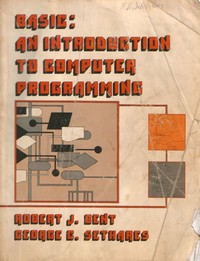BASIC: An Introduction to Computer Programming
| Home > Browse Our Collection > Books > BASIC > BASIC: An Introductio ... Computer Programming |
|
This book is intended for an audience with no prior programming experience. A mathematics background of elementary algebra is sufficient for most of the material. Those sections involving more advanced topics in mathematics, such as the trigonometric functions, may be omitted with no loss of continuity. During the past three years the material has been tested successfully in a one-semester course for nonscience majors. It has also been used, with equal success, in both a one-quarter course and a one-semester course for mathematics and science majors.
We wrote this book with two principal goals in mind. First, we felt it important to present the elements of BASIC so that meaningful computer programs could be written at the earliest possible time. We adhere to the notion that one learns by doing. As a result, problem solving is emphasized from the beginning, and the various aspects of the BASIC language are introduced only as needed. Our second goal was to write a book that would serve as a general introduction to computer programming, not just to a programming language. Simply describing a variety of computer applications and ways to go about writing BASIC programs for these applications does not constitute an introduction to programming. What is required is a consideration of the entire programming process. The approach we have taken toward this objective is to introduce programming principles only as they can be understood and appreciated in the context of the applications being considered. For example, a beginner can easily appreciate the necessity of choosing variable names and determining how they are related. Hence, this step is introduced very early, even though it will later be found that this is one of the last steps normally taken by a programmer. On the other hand, the value of modularization is not so easily grasped in the context of the straightforward programming problems first encountered. As natural as modularization may appear to an experienced programmer, a beginner must "see" its usefulness before being convinced of its value. Therefore, this programming principle is not introduced until much later in the book. Throughout the text we have attempted to conform to the most common BASIC usage. BASIC is not a static language. It seems that each new BASIC implementation contains what the designers consider to be "improvements." Although the many forms that BASIC assumes on different systems may please Proteus, they do nothing for the poor programmer. To help resolve this dilemma, the American National Standards Institute (ANSI) prepared a document, dated December 1, 1976, entitled "Proposed American National Standard for Minimal BASIC." In all but two instances, which are clearly identified, our presentation of minimal BASIC conforms to the ANSI standard. Publisher : Brooks / Cole Author : Robert J. Bent & George C. Sethares Format : Paperback: 239 Pages This exhibit has a reference ID of CH2394. Please quote this reference ID in any communication with the Centre for Computing History. |










